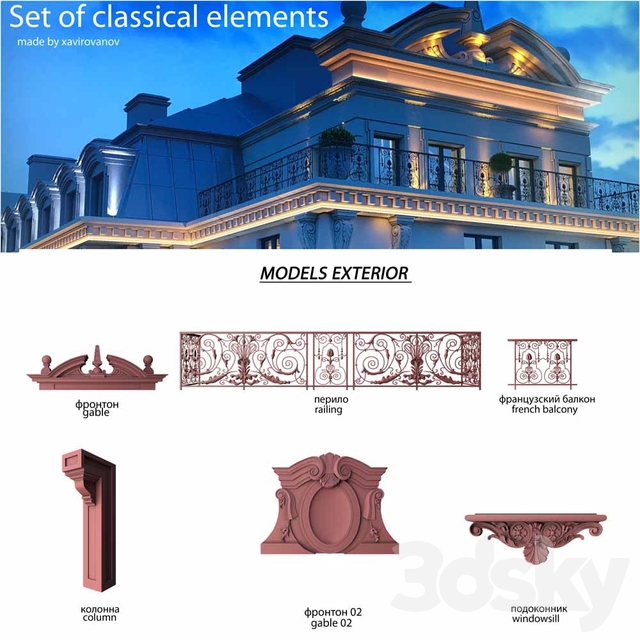
3d Modeli Balyasin
A set of 22 elements, Some models of the firm dikart, I prepared for the railclone, part of the textures, for ease of use. A set of 22 elements, Part dikart models of firm, I prepared for railclone, textured part, for ease of use.
2018-08-20 0.5. 2018-04-16 0.6 2018-04-16.
Http: // www.dikart.ru/catalog/friezes/2029/?content=content&#content http: // www. Dikart.ru/catalog/baseboards/2082/?content=content&#content catalog / smooth-rods / 4147 /? Content = content & # content smooth-rods / 1243 /? Content = content & # content figure / 1183 /? Content = content & # content = content & # content ntent & # content http://www.dikart.ru/catalog/karinizi-with-figure/1225/?content=content&#content.
† Author contributions: G.S.L.T.: conception and design, collection and/or assembly of data, data analysis and interpretation, and manuscript writing; J.A.A. And R.M.: conception and design, collection and/or assembly of data, and data analysis and interpretation; S.E.B. And K.S.: collection and/or assembly of data; T.E.S.: collection and/or assembly of data and data analysis and interpretation; A.M.D.: data analysis and interpretation; J.M.K.: conception and design, financial support, data analysis and interpretation, and manuscript writing; C.V.C.: conception and design, financial support, collection and/or assembly of data, data analysis and interpretation, manuscript writing, and final approval of manuscript. Systemically administered adult mesenchymal stem cells (MSCs), which are being explored in clinical trials to treat inflammatory disease, exhibit the critical ability to extravasate at sites of inflammation. We aimed to characterize the basic cellular processes mediating this extravasation and compare them to those involved in leukocyte transmigration. Using high‐resolution confocal and dynamic microscopy, we show that, like leukocytes, human bone marrow‐derived MSC preferentially adhere to and migrate across tumor necrosis factor‐α‐activated endothelium in a vascular cell adhesion molecule‐1 (VCAM‐1) and G‐protein‐coupled receptor signaling‐dependent manner. Nlp the mind control manual pdf.
As several studies have suggested, we observed that a fraction of MSC was integrated into endothelium. In addition, we observed two modes of transmigration not previously observed for MSC: Paracellular (between endothelial cells) and transcellular (directly through individual endothelial cells) diapedesis through discrete gaps and pores in the endothelial monolayer, in association with VCAM‐1‐enriched “transmigratory cups”.
Contrasting leukocytes, MSC transmigration was not preceded by significant lateral migration and occurred on the time scale of hours rather than minutes. Interestingly, rather than lamellipodia and invadosomes, MSC exhibited nonapoptotic membrane blebbing activity that was similar to activities previously described for metastatic tumor and embryonic germ cells. Our studies suggest that low avidity binding between endothelium and MSC may grant a permissive environment for MSC blebbing.
MSC blebbing was associated with early stages of transmigration, in which blebs could exert forces on underlying endothelial cells indicating potential functioning in breaching the endothelium. Collectively, our data suggest that MSC transmigrate actively into inflamed tissues via both leukocyte‐like and novel mechanisms. S TEM C ELLS 20–2486.
INTRODUCTION More than 100 clinical trials currently evaluate adult “mesenchymal stem cells” (MSCs) or “multipotent stromal cells” for treatment of diverse inflammatory, cardiovascular, and autoimmune diseases [ ]. Approximately half of the clinical trials involve the systemic infusion of MSC into the vascular circulation [ ].
Preclinical animal studies demonstrate that infused MSC preferentially engraft into inflamed or ischemic tissues, a behavior that is thought to be critical for their therapeutic efficacy [ ]. Additionally, physiological homing ability of endogenous MSC is supported by studies reporting that endogenous MSC can be mobilized from the bone marrow and recruited into wounds [ ], tumors [ ], ectopic endometrial tissue in endometriosis [, ], and sites of intimal hyperplasia [ ]. A critical step in such recruitment and engraftment is the exit of MSC from the vascular circulation (i.e., extravasation), which requires crossing the endothelial cell (EC) barrier that lines blood vessels. For MSC, this process of extravasation remains incompletely understood. In contrast, the process of leukocyte extravasation at sites of inflammation has been well‐characterized as a dynamic and rapid (time scale of minutes) multistep cascade (Fig.
During inflammation, endothelium becomes activated by cytokines such as tumor necrosis factor‐α (TNF‐α). They then upregulate chemoattractants and surface proteins, including selectins and cell adhesion molecules (CAMs), which mediate rolling and adhesive interactions, respectively. Subsequently, leukocytes initiate a phase of lateral migration over the luminal surface and use dynamic cytoskeletal protrusions (e.g., lamellipodia, pseudopods, and invadosomes) to cross the endothelium through discrete gaps in intercellular junctions (i.e., “paracellular diapedesis”) or directly through pores in individual ECs (i.e., “transcellular diapedesis”) [ -].